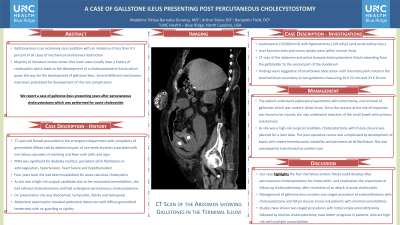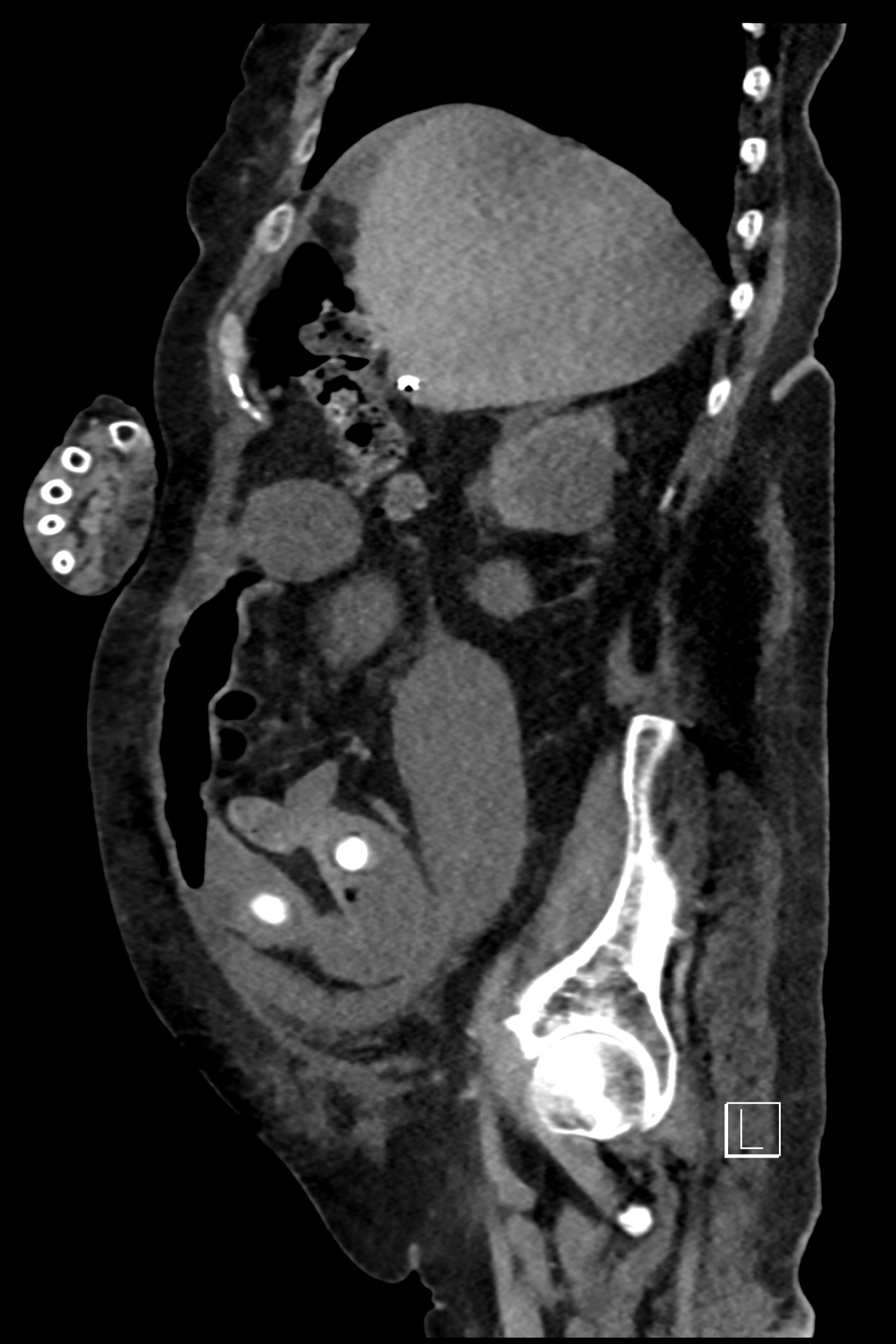Tuesday Poster Session
Category: Biliary/Pancreas
P2952 - A Case of Gallstone Ileus Presenting Post Percutaneous Cholecystostomy
Tuesday, October 24, 2023
10:30 AM - 4:00 PM PT
Location: Exhibit Hall

Has Audio

Madeline Vithya Barnaba Durairaj, MBBS, MD, DM
UNC Health Blue Ridge
Morganton, NC
Presenting Author(s)
Madeline Vithya Barnaba Durairaj, MBBS, MD, DM, Arthur Stone, DO, Benjamin Field, DO
UNC Health Blue Ridge, Morganton, NC
Introduction: Gallstone ileus is an extremely rare condition with an incidence of less than 0.5% of all cases of mechanical small bowel obstruction. Literature review shows that most cases have a history of cholecystitis leading to the development of a cholecystoenteric fistula. Several different mechanisms have been postulated for development of this rare complication. We report a case of gallstone ileus presenting years after percutaneous cholecystostomy which was performed for acute cholecystitis.
Case Description/Methods: A 77-year-old female presented to the emergency department with diffuse colicky abdominal pain of one week duration associated with non-bilious episodes of vomiting and fever. Past medical history was significant for diabetes mellitus, persistent atrial fibrillation, heart failure and hypothyroidism. Four years back she had undergone percutaneous cholecystostomy for an attack of acute calculous cholecystitis in view of her associated multiple comorbidities.
On admission she was disoriented, tachycardic, febrile and tachypneic. Examination revealed abdominal distension with diffuse tenderness with no guarding or rigidity. Investigations showed leukocytosis, hyponatremia and acute kidney injury. Liver function tests were normal. CT abdomen and pelvis showed cholecystoenteric fistula extending from the gallbladder to the second part of the duodenum along with small bowel obstruction. The transition point was noted in the terminal ileum secondary to two gallstones measuring 20 X 22 mm and 23 X 20 mm respectively (Image 1). Enterotomy with removal of gallstones along with resection of the small bowel with primary anastomosis was performed. As she was a high-risk surgical candidate, cholecystectomy with fistula closure was planned for a later date. Post-operatively she developed sepsis with severe hemodynamic instability and persistent atrial fibrillation. She was subsequently transitioned to comfort care.
Discussion: This case highlights that biliary-enteric fistula could develop after percutaneous cholecystostomy for cholecystitis and emphasizes the importance of follow-up cholecystectomy, after resolution of an attack of acute cholecystitis. Management of gallstone ileus involves one staged procedure of enterolithotomy with cholecystectomy and fistula closure in low-risk patients. Studies have shown two staged procedures with initial simple enterolithotomy followed by elective cholecystectomy, have better prognosis in high-risk patients.

Disclosures:
Madeline Vithya Barnaba Durairaj, MBBS, MD, DM, Arthur Stone, DO, Benjamin Field, DO. P2952 - A Case of Gallstone Ileus Presenting Post Percutaneous Cholecystostomy, ACG 2023 Annual Scientific Meeting Abstracts. Vancouver, BC, Canada: American College of Gastroenterology.
UNC Health Blue Ridge, Morganton, NC
Introduction: Gallstone ileus is an extremely rare condition with an incidence of less than 0.5% of all cases of mechanical small bowel obstruction. Literature review shows that most cases have a history of cholecystitis leading to the development of a cholecystoenteric fistula. Several different mechanisms have been postulated for development of this rare complication. We report a case of gallstone ileus presenting years after percutaneous cholecystostomy which was performed for acute cholecystitis.
Case Description/Methods: A 77-year-old female presented to the emergency department with diffuse colicky abdominal pain of one week duration associated with non-bilious episodes of vomiting and fever. Past medical history was significant for diabetes mellitus, persistent atrial fibrillation, heart failure and hypothyroidism. Four years back she had undergone percutaneous cholecystostomy for an attack of acute calculous cholecystitis in view of her associated multiple comorbidities.
On admission she was disoriented, tachycardic, febrile and tachypneic. Examination revealed abdominal distension with diffuse tenderness with no guarding or rigidity. Investigations showed leukocytosis, hyponatremia and acute kidney injury. Liver function tests were normal. CT abdomen and pelvis showed cholecystoenteric fistula extending from the gallbladder to the second part of the duodenum along with small bowel obstruction. The transition point was noted in the terminal ileum secondary to two gallstones measuring 20 X 22 mm and 23 X 20 mm respectively (Image 1). Enterotomy with removal of gallstones along with resection of the small bowel with primary anastomosis was performed. As she was a high-risk surgical candidate, cholecystectomy with fistula closure was planned for a later date. Post-operatively she developed sepsis with severe hemodynamic instability and persistent atrial fibrillation. She was subsequently transitioned to comfort care.
Discussion: This case highlights that biliary-enteric fistula could develop after percutaneous cholecystostomy for cholecystitis and emphasizes the importance of follow-up cholecystectomy, after resolution of an attack of acute cholecystitis. Management of gallstone ileus involves one staged procedure of enterolithotomy with cholecystectomy and fistula closure in low-risk patients. Studies have shown two staged procedures with initial simple enterolithotomy followed by elective cholecystectomy, have better prognosis in high-risk patients.

Figure: CT scan of the abdomen showing gallstones in the terminal ileum
Disclosures:
Madeline Vithya Barnaba Durairaj indicated no relevant financial relationships.
Arthur Stone indicated no relevant financial relationships.
Benjamin Field indicated no relevant financial relationships.
Madeline Vithya Barnaba Durairaj, MBBS, MD, DM, Arthur Stone, DO, Benjamin Field, DO. P2952 - A Case of Gallstone Ileus Presenting Post Percutaneous Cholecystostomy, ACG 2023 Annual Scientific Meeting Abstracts. Vancouver, BC, Canada: American College of Gastroenterology.
